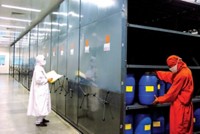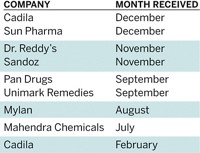Advertisement
Grab your lab coat. Let's get started
Welcome!
Welcome!
Create an account below to get 6 C&EN articles per month, receive newsletters and more - all free.
It seems this is your first time logging in online. Please enter the following information to continue.
As an ACS member you automatically get access to this site. All we need is few more details to create your reading experience.
Not you? Sign in with a different account.
Not you? Sign in with a different account.
ERROR 1
ERROR 1
ERROR 2
ERROR 2
ERROR 2
ERROR 2
ERROR 2
Password and Confirm password must match.
If you have an ACS member number, please enter it here so we can link this account to your membership. (optional)
ERROR 2
ACS values your privacy. By submitting your information, you are gaining access to C&EN and subscribing to our weekly newsletter. We use the information you provide to make your reading experience better, and we will never sell your data to third party members.
Business
India As World’s Drugstore
Pharmaceuticals: Country sets ambitious medicine export targets at CPhI meeting
by Jean-François Tremblay
October 28, 2013
| A version of this story appeared in
Volume 91, Issue 43

India hopes to export $25 billion worth of pharmaceuticals in 2016, an increase of more than $10 billion from current levels. Government officials announced the export target last week at CPhI, the world’s largest pharmaceutical ingredients trade fair.
India aims to achieve the much higher drug sales despite challenges to its patent regime by Western countries and at a time when the image of its pharmaceutical industry is tarnished by quality problems at prominent firms.
The country’s optimism is buoyed by its recent performance. Over the past four years, exports have risen on average by 24% annually, according to the India Brand Equity Foundation, a government-sponsored group. Claiming that India is already the world’s largest exporter of generic pharmaceuticals, IBEF says it wants to position India as the “pharmacy of the world.”
“Thanks to our expertise, quality standards, and cost-effective manufacturing techniques, we have been able to lower the cost of vital medicines in the developing world,” said Sudhanshu Pandey, joint secretary in the Indian Ministry of Commerce & Industry, in a statement issued before CPhI.
But India will face a number of challenges. The country’s pharmaceutical industry is striving to clean up its image after reports that it does not abide by environmental and quality standards. For example, Swedish researchers found in 2007 that water near pharmaceutical plants in Patancheru, an industrial district near Hyderabad, was heavily contaminated by antibiotics.
And in recent years, U.S. and European regulators have banned pharmaceuticals from leading Indian firms including Wockhardt, Aurobindo, and Ranbaxy Laboratories for poor quality. The U.S. Department of Justice slapped Ranbaxy with a fine of $500 million—the largest ever for a generics producer—after FDA found numerous breaches of manufacturing protocols at its plants.
India’s export goals may also come up against pressure from the U.S. and Europe for the country to tighten its patent laws. Western drugmakers complain that many of the drugs India exports are patented in the West but not in India or the developing countries where they are sold.
MORE ON THIS STORY
- - CPhI Day One: Theme Time
- - CPhI Day Two: Complexity Prevails
- - CPhI Day Three: All the King’s Horses?




Join the conversation
Contact the reporter
Submit a Letter to the Editor for publication
Engage with us on Twitter